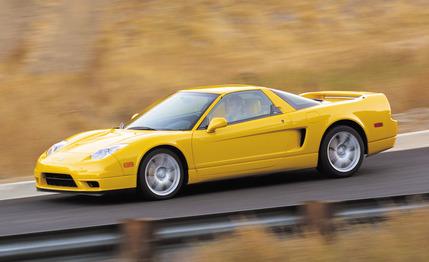
 First Drive Review
First Drive Review
"Most underrated" is an expression usually employed by sportscasters, as in, "He's one of the most underrated fullbacks in the league." Who's in charge of underratings? That's not clear. But it is clear that this description applies to the Acura NSX.
It's svelte, it's sleek, it's far from slow, it offers a higher comfort quotient than anything else in its class, and yet its sales pace is, to be kind, glacial-about 15 per month in this country. And this in a record sales year for Acura.
What's up with that? We think it's a blend of problems that may not be cured by the face lift we're looking at here. But let's address the big picture a little later.
As you can see, the 2002 NSX has swapped its pop-up headlights in favor of fixed high-intensity-discharge units with integrated parking lamps. Acura says the HIDs throw out twice the lumens of halogens. Whether they improve the car's appearance, however, is debatable.
Other changes: The front air dam is a little deeper, the taillight housings have been revised, there's a lip spoiler atop the trunklid, and the exhaust tips are new.
Inside, Acura has made several subtle revisions, including new sew patterns for the seats, and the option of interior color schemes coordinated with exterior hues is offered.
Aside from the headlights, all these updates take a practiced eye to spot. There are, however, some functional benefits to the subtle resculpting. The coefficient of drag drops a couple of points, to 0.30, which improves the NSX's 0-to-125-mph time by 0.2 second, according to Acura, and its top speed from 168 to 175 mph.
That's all very well, but what's going on under the car is easier to translate into everyday benefits. Acura has increased the front spring rates, beefed up the rear anti-roll bar (from 17.5mm to 19.1), and added more authority to the wheel-and-tire package. The front wheels (forged aluminum alloy all-around) go from 7.0-by-16 inches to 7.0-by-17s, the rears from 8.5-by-17 to 9.0-by-17s. Tire specs change from 215/45-16 to 215/40-17 in front and 245/40-17 to 255/40-17 in the rear.
Based on a half-day of terrorizing back roads in California's Santa Cruz Mountains, that extra 10mm of rear contact patch, along with the benefits of the retuned suspension, seem to reduce oversteer and increase driver certainty in a world of varying radii.
This brings us to the question of how the NSX's performance compares with that of the other big-name players in this general price realm. At 290 horsepower, its all-aluminum 3.2-liter (automatic versions get a 252-hp 3.0-liter) DOHC 24-valve VTEC V-6 is on the light side of the power ledger compared with its competition. The Porsche 911 Carrera flat-six is up to 3.6 liters and 315 hp (from 3.4 and 300) for 2002, the '02 Corvette Z06 V-8 serves up 405 hp (up from 385 in '01), and the Dodge Viper V-10 brings 450 ponies to the party, with 500 due next year.
The last NSX we tested (July 1999) was an Alex Zanardi limited-edition model, which scaled in much lighter (2970 pounds versus 3153) than the curb weight Acura lists for the 2002 model. It sprinted to 60 mph in 4.8 seconds, covered the quarter-mile in 13.2 at 106 mph, stopped from 70 mph in 164 feet, and pulled 0.93 g on the skidpad.
Respectable numbers, but not extraordinary. Our long-term 1999 Carrera (May 2001) was about the same in its wrap-up runs (0 to 60 in 4.8 seconds; 13.4 seconds at 105 mph in the quarter-mile), with 19 fewer ponies than the '02 version.
Our most recent Viper test numbers are a year old (February '01). That Viper, a 460-hp GTS ACR model, hit 60 mph in 4.3 seconds and ran the quarter in a robust 12.6 seconds at 114 mph. The Z06 from that same test recorded 4.0 seconds and 12.4 at 116.
These look like small distinctions, and a rational person might say, "So what?" But the world of high-performance sports cars isn't a purely rational one. It doesn't matter whether you can really exploit all that potential. It's the mere possession that counts.
And when you can possess more potential for less money than an NSX, Acura's sexy supersport, for all its sophistication, rings up as a tough sell. The numbers: a 2001 NSX, with the removable roof (standard for '02), carried a base price of $90,879. A 2001 Carrera C4 (all-wheel drive) was $74,156, a 2002 Viper GTS is $74,071, and a 2002 Corvette Z06 is $50,721.
We continue to love this car. But we think these modest updates on an aging (introduced in 1990), pricey exotic are similar to rearranging deck chairs on the Titanic. Will they be enough to keep the NSX afloat?